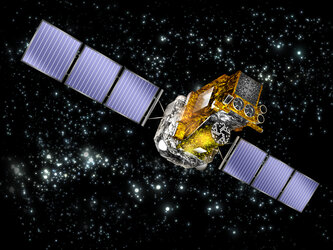XMM-Newton discovers part of missing matter in the Universe
ESA’s orbiting X-ray observatory XMM-Newton has been used by a team of international astronomers to uncover part of the missing matter in the Universe.
Ten years ago, scientists predicted that about half of the ‘ordinary’ or normal matter made of atoms exists in the form of low-density gas, filling vast spaces between galaxies.
All the matter in the Universe is distributed in a web-like structure. At dense nodes of the cosmic web are clusters of galaxies, the largest objects in the Universe. Astronomers suspected that the low-density gas permeates the filaments of the web.
The low density of the gas hampered many attempts to detect it in the past. With XMM-Newton’s high sensitivity, astronomers have discovered its hottest parts. The discovery will help them understand the evolution of the cosmic web.
Only about 5% of our Universe is made of normal matter as we know it, consisting of protons and neutrons, or baryons, which along with electrons, form the building blocks of ordinary matter. The rest of our universe is composed of elusive dark matter (23%) and dark energy (72%).

Small as the percentage might be, half of the ordinary baryonic matter is unaccounted for. All the stars, galaxies and gas observable in the universe account for less than a half of all the baryons that should be around.
Scientists predicted that the gas would have a high temperature and so it would primarily emit low-energy X-rays. But its very low density made observation difficult.
Astronomers using XMM-Newton were observing a pair of galaxy clusters, Abell 222 and Abell 223, situated at a distance of 2300 million light-years from Earth, when the images and spectra of the system revealed a bridge of hot gas connecting the clusters.
"The hot gas that we see in this bridge or filament is probably the hottest and densest part of the diffuse gas in the cosmic web, believed to constitute about half the baryonic matter in the Universe," says Norbert Werner from SRON Netherlands Institute for Space Research, leader of the team reporting the discovery.

“The discovery of the warmest of the missing baryons is important. That’s because various models exist and they all predict that the missing baryons are some form of warm gas, but the models tend to disagree about the extremes,” adds Alexis Finoguenov, a team member.
Even with XMM-Newton’s sensitivity, the discovery was only possible because the filament is along the line of sight, concentrating the emission from the entire filament in a small region of the sky. The discovery of this hot gas will help better understand the evolution of the cosmic web.
"This is only the beginning. To understand the distribution of the matter within the cosmic web, we have to see more systems like this one. And ultimately launch a dedicated space observatory to observe the cosmic web with a much higher sensitivity than possible with current missions. Our result allows to set up reliable requirements for those new missions," concludes Norbert Werner.
ESA’s XMM-Newton Project Scientist, Norbert Schartel, comments on the discovery, “This important breakthrough is great news for the mission. The gas has been detected after hard work and more importantly, we now know where to look for it. I expect many follow-up studies with XMM-Newton in the future targeting such highly promising regions in the sky.”
For more information:
Norbert Werner, SRON Netherlands Institute for Space Research
Email: N.Werner @ sron.nl
Norbert Schartel, ESA XMM-Newton Project Scientist
Email: Norbert.Schartel @ esa.int
Notes for editors:
The article 'Detection of hot gas in the filament connecting the clusters of galaxies Abell 222 and Abell 223', by N. Werner, A. Finoguenov, J. Kaastra, A. Simionescu, J. Dietrich, J. Vink and H. Böhringer' has been published in the Astronomy & Astrophysics Letters on 17 March 2008.
The team of astronomers that made the discovery includes N. Werner (SRON, Netherlands Institute for Space Research), A. Finoguenov (MPE, Germany), A. Simionescu, H. Böhringer (MPE, Germany), J. Kaastra (SRON, Netherlands Institute for Space Research and Utrecht University, Netherlands), J. Dietrich (ESO, Germany) and J. Vink (Utrecht University, Netherlands).















 Germany
Germany
 Austria
Austria
 Belgium
Belgium
 Denmark
Denmark
 Spain
Spain
 Estonia
Estonia
 Finland
Finland
 France
France
 Greece
Greece
 Hungary
Hungary
 Ireland
Ireland
 Italy
Italy
 Luxembourg
Luxembourg
 Norway
Norway
 The Netherlands
The Netherlands
 Poland
Poland
 Portugal
Portugal
 Czechia
Czechia
 Romania
Romania
 United Kingdom
United Kingdom
 Slovenia
Slovenia
 Sweden
Sweden
 Switzerland
Switzerland






































